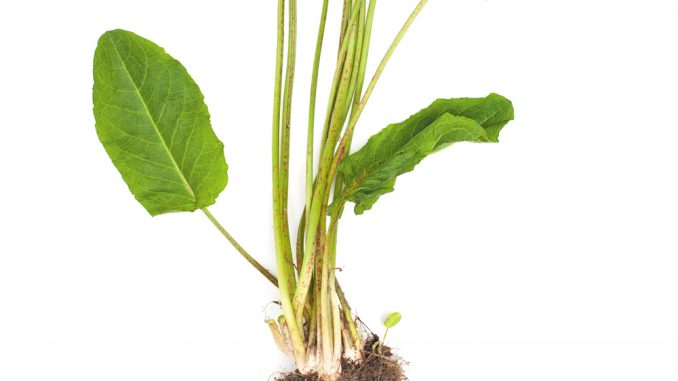
Name: Curly Dock

The growing rosette of curly dock leaves.
(Rumex crispus)
Curly dock is a member of the buckwheat family, which has 48 genera and about 1,200 species worldwide. One such genus is Rumex, which has approximately 200 species worldwide, with about 63 species available in North America.
The seeds and cooked leaves of most species of Rumex can be eaten, but they are not all readily palatable.
Description
Curly dock is most easily recognized by the conspicuous chocolate or coffee-brown seed stalk of autumn, which can grow to about 4 feet tall. The seeds are clustered in threes and are attached to papery wings.
The dark green leaves are lanceolate-shaped with a wavy or curly margin, which gives it the “curly” part of its name. The leaves can measure up to a foot long.
The root looks similar to an orange carrot, though it is knottier and darker in color.
Where Found
Though a European native, this prepper plant is now common and widespread in the United States.
It is found in agricultural lands, swamps, fields, gardens, ditches and vacant lots. Though it prefers wet soils, it can be found in most environments.
When to Harvest/Availability

The student on the right is processing the brown curly dock seeds so they can be added to pancake batter.
The leaves are best gathered in the spring, when they have not yet become bitter and astringent. The seeds are collected by late August, when they mature and turn chocolate brown.
Uses
Curly dock leaves are a bit sour when raw, and they turn bitter as they mature. The young leaves are good chopped and added to salads. The sour stems provide a tasty trail nibble.
The leaves can also be steamed like spinach, and served lightly seasoned, ideally mixed with other greens or vegetables. When cooking, the leaves turn from green to almost brown. The texture of the cooked leaves is slightly mucilaginous.
Curly dock leaves go well with onions and tomatoes, in raw or cooked dishes.
The seeds can be used to make flour. They should be collected and winnowed and then ground.
The flour can be used alone, but it is better mixed with another flour such as wheat.
PROCESSING
No special processing is required for the leaves of this prepper plant. Think of them as lettuce or spinach.
Even the seeds can be hand-winnowed and used in various batters. However, a finer flour is produced by running the seed through a home flour mill.
MEDICINE/NUTRITION
100 grams of curly dock leaves, cooked, contains 66 mg of calcium, 41 mg of phosphorus, 338 mg of potassium, 119 mg of vitamin C and 12,900 IU of vitamin A – that’s a lot!
Fresh leaves of curly dock can be crushed and rubbed on areas of the skin that have been stung by nettles, to relieve the stinging.
In Western herbalism, the root is often used for treating anemia, due to its high level of iron.
Herbalists the world over use the root for many physical ailments. I suggest reading Michael Moore’s “Medicinal Plants of the Mountain West” for more details.
OTHER USES
The coffee-colored curly dock seed stalks are commonly cut and used in dried floral arrangements.
Advice for Growing
If you wish to have curly dock growing in your yard, simply scatter some of the mature seeds during the winter, or dig up a wild root and plant it in your yard. These are very easy to grow.
Cautions
Though curly dock has many good uses, it is often despised and poisoned in agricultural areas because it not only survives well but often takes over entire areas.
It is often advised to eat only curly dock leaves that have been double-boiled. This is partly because of the presence of oxalic acid and partly to reduce the bitterness of the more-mature leaves.
Recipes

Cooked curly dock with tomatoes and onions. The hard-boiled egg is added to provide protein.
Sweet, Sour and Salty
- 2 cups white or red onions, coarsely chopped
- 2 cups tomatoes, diced
- 2 cups curly dock leaves, cleaned and chopped
- Garlic salt
- Butter
Add about 2 tablespoons of butter to your cast iron or stainless steel skillet. Sauté the onions until they are thoroughly cooked. Don’t rush this step — cook them until they actually become “sweet.” Keep a lid on the skillet during cooking.
Add the diced tomatoes, cover and let cook for about 3 minutes. Add the chopped curly dock leaves, stir in well, cover, and let cook until the leaves are brownish-green, about 5 minutes.
This simple vegetable mix has a delicious flavor, combining three different flavored foods that complement one another quite well.
This was a favorite of John Watkins, a wild food forager (among other professions) who grew up in the South.
Serves 3 or 4

Some just-cooked curly dock seed pancakes, fresh out of the pan.
Rim of the World Lunch (Creamed Dock)
- 2 cups curly dock leaves, cooked
- 1 cup mustard leaves, cooked
- 1/2 onion, cooked and diced
- 2 tablespoons whole wheat or potato flour
- 3/4 cup milk (can be made from powdered milk)
- 1/2 teaspoon salt
- 2 tablespoons butter
Cook the mustard and curly dock leaves. Measure out 2 cups of cooked leaves. Chop well.
Melt the butter in a skillet (with a lid) and add the flour. Mix well, and then add the onion (already cooked and diced), chopped greens, and the milk.
Stir and cover for about 5 minutes.
Serve with salt to taste.
Serves 3
About ASG’s Plant Advisor
Christopher Nyerges has been teaching ethnobotany since 1974. He is the author of Guide to Wild Foods and Useful Plants, Foraging Wild Edible Plants of North America, and other books on the uses of wild plants. He can be reached at SchoolofSelf-Reliance.com.
Editor’s note: A version of this article first appeared in the June, 2020 print issue of American Survival Guide.





Be the first to comment